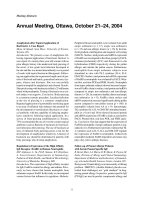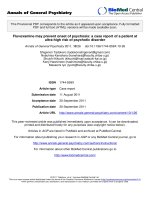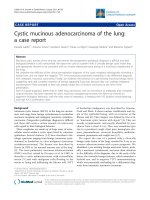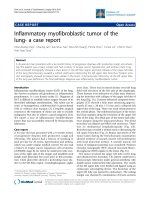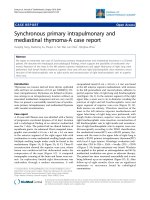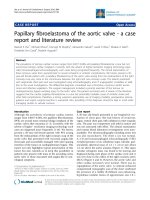Báo cáo y học: " Fatal hemolytic anemia associated with metformin: A case report" ppsx
Bạn đang xem bản rút gọn của tài liệu. Xem và tải ngay bản đầy đủ của tài liệu tại đây (196.51 KB, 4 trang )
BioMed Central
Page 1 of 4
(page number not for citation purposes)
Journal of Medical Case Reports
Open Access
Case report
Fatal hemolytic anemia associated with metformin: A case report
Clifford D Packer*
1,2
, Thomas R Hornick
1,2
and Sarah A Augustine
1,2
Address:
1
Louis Stokes Cleveland Veterans Affairs Medical Center, East Boulevard, Cleveland, OH 44106, USA and
2
Case Western Reserve
University School of Medicine, 10900 Euclid Avenue, Cleveland, OH 44106, USA
Email: Clifford D Packer* - ; Thomas R Hornick - ;
Sarah A Augustine -
* Corresponding author
Abstract
Introduction: Metformin is a widely prescribed biguanide antidiabetic drug that has been
implicated as a cause of hemolytic anemia in three previous case reports. We report a case of
rapidly fatal hemolysis that was temporally associated with the initiation of metformin treatment
for diabetes. Clinicians need to be aware of this rare but potentially serious side effect of
metformin.
Case presentation: A 56-year-old Caucasian man with type 2 diabetes mellitus was started on
metformin to improve glycemic control. Shortly afterwards, he developed progressive fatigue,
exertional dyspnea, cranberry-colored urine and jaundice. Laboratory studies showed severe
hemolysis, with a drop in hemoglobin from 14.7 to 6.6 g/dl over 4 days, markedly elevated lactate
dehydrogenase, bilirubin and reticulocyte counts, and a low haptoglobin level. A peripheral blood
smear showed no schistocytes, and a direct Coombs test was positive for anti-IgG and negative for
anti-C3. Despite corticosteroid treatment and transfusion of packed red blood cells, the patient
developed increasing dyspnea, hypotension, further decline in hemoglobin to 3.3 g/dl, and fatal
cardiorespiratory arrest 12 hours after admission.
Conclusion: The serologic findings in this case suggest an autoimmune hemolytic anemia, caused
either by a drug-induced autoantibody or a warm autoantibody. Based on the temporal association
with metformin and the lack of other clear precipitating causes, we propose that metformin-
induced hemolysis with a drug-induced autoantibody is a strong possibility. This mechanism differs
from a previously described case with a possible antibody to the erythrocyte-drug complex. It has
been shown, however, that hemolysis may occur via multiple mechanisms from the same drug.
Clinicians should consider the possibility of metformin-associated immune hemolytic anemia in
patients with otherwise unexplained hemolysis.
Introduction
Metformin-induced hemolytic anemia has been reported
in three patients, all of whom recovered when metformin
was discontinued [1-3]. We report the case of a patient
with fulminant and fatal hemolysis that occurred shortly
after metformin was started for the treatment of type 2
diabetes mellitus.
Published: 10 September 2008
Journal of Medical Case Reports 2008, 2:300 doi:10.1186/1752-1947-2-300
Received: 25 January 2008
Accepted: 10 September 2008
This article is available from: />© 2008 Packer et al; licensee BioMed Central Ltd.
This is an Open Access article distributed under the terms of the Creative Commons Attribution License ( />),
which permits unrestricted use, distribution, and reproduction in any medium, provided the original work is properly cited.
Journal of Medical Case Reports 2008, 2:300 />Page 2 of 4
(page number not for citation purposes)
Case presentation
A 56-year-old Caucasian man with type 2 diabetes melli-
tus, hypothyroidism, idiopathic thrombocytopenic pur-
pura status post splenectomy in 1979, and remote
testicular cancer status post orchiectomy and radiation
therapy in the 1970s was admitted with 2 days of progres-
sive fatigue, exertional dyspnea, low back pain and cran-
berry-colored urine. He had been started on metformin
500 mg twice a day 4 days previously for type 2 diabetes
but called in to his physician the following day with com-
plaints of "palpitation, heavy breathing, and tossing and
turning last night" after taking the metformin, which he
declined to continue. Two days before admission he was
seen at an outside emergency room with hematuria and
anemia; he was diagnosed with a urinary tract infection
and started on oral ciprofloxacin. His other medications
were pantoprazole, levothyroxine and glyburide. On the
day of admission, vital signs were temperature 37.1°C,
pulse rate of 133 per minute, respiration rate of 32 breaths
per minute, blood pressure of 155/84 and pulse oxygen
94% on 6 liters O
2
. Physical examination was significant
for respiratory distress, scleral icterus and generalized
jaundice. There was no jugular venous distention and no
enlarged thyroid gland or lymphadenopathy. His lungs
were clear, heart sounds were distant, his abdomen was
soft without masses or enlargement of organs, he had no
rashes and no peripheral edema. Mild lumbar and tho-
racic spinous tenderness was noted; neurological exami-
nation revealed mild lethargy but otherwise normal
mental status, with no focal findings. Laboratory studies
(Table 1) were significant for hemoglobin of 6.6 g/dl,
which had dropped from 14.7 g/dl 4 days before, total
bilirubin 6.6 mg/dl (direct 2.7 mg/dl), reticulocyte count
3.51%, lactate dehydrogenase 4829 U/l, and haptoglobin
less than 6 mg/dl, all consistent with severe hemolysis.
The direct antiglobulin (Coombs) test (DAT) was positive
for anti-IgG and negative for anti-C3. The peripheral
blood smear on admission significantly showed no schis-
tocytes; 4% immature granulocytes and 4% nucleated red
blood cells (RBCs) were noted. Other significant findings
included marked leukocytosis to 46.1 K/cmm, acute renal
failure, elevation of troponin-I and marked transaminase
elevations (aspartate aminotransferase (AST) 1711,
alanine aminotransferase (ALT) 806) with normal inter-
national normalized ratio and alkaline phosphatase.
Blood and urine cultures showed no growth. Despite
treatment with corticosteroids and transfusion of packed
RBCs, the patient became increasingly dyspneic and agi-
tated, complained of abdominal pain and developed
hypotension followed by cardiorespiratory arrest approx-
imately 8 hours after admission. Over the next 4 hours he
was treated following the advanced cardiac life support
protocol for recurrent bouts of pulseless electrical activity
and asystole, with worsening hyperkalemia and metabolic
acidosis. Despite transfusion, hemoglobin was noted to
have declined to 3.3 g/dl. The patient died approximately
12 hours after admission.
Table 1: Laboratory test results
Variable 11/21/2006 11/20/2006 11/16/2006 9/21/2006 Units
Hemoglobin 3.3 6.6 14.7 - g/dl
Hematocrit 10.2 19.5 43.3 - %
Platelet 97 166 322 - K/cmm
White blood cell 44.0 46.1 11.5 - K/cmm
Glucose - 277 - 220 mg/dl
Blood urea nitrogen - 38 - 22 mg/dl
Creatinine - 2.4 - 1.1 mg/dl
Sodium - 129 - 140 meq/l
Potassium - 5.5 - 4.5 meq/l
Chloride - 94 - 104 meq/l
CO
2
- 15 - 27 mmol/l
Calcium - 8.7 - 9.2 mg/dl
Lactate dehydrogenase - 4829 - - U/l
Haptoglobin - <6 - - mg/dl
Fibrinogen - 253 - - mg/dl
Total bilirubin - 6.9 - 0.8 mg/dl
Direct bilirubin - - - 0.1 mg/dl
Alkaline phosphatase - 103 - 83 U/l
Alanine aminotransferase - 806 - 38 U/l
Aspartate aminotransferase - 1711 - 31 U/l
Creatine phosphokinase - 597 - - U/l
Partial thromboplastin time - 26.7 - - seconds
International normalized ratio - 1.22 - - -
Journal of Medical Case Reports 2008, 2:300 />Page 3 of 4
(page number not for citation purposes)
Discussion
The temporal relationship with metformin ingestion is
strong in this case, with the patient noting symptoms
within hours of the initiation of metformin. The 4-day
course was rapid and fatal, characterized by massive
hemolysis and shock. In the three previously reported
cases of metformin-induced hemolytic anemia (Table 2),
the time to onset of symptoms ranged from 9 to 14 days
after starting metformin, and none resulted in massive
hemolysis or death. Glucose-6-phosphate dehydrogenase
(G6PD) levels and the results of the DAT were variable. In
two of the three cases the hemolysis recurred with met-
formin rechallenge, which increases the likelihood of a
causal relationship according to the Naranjo adverse drug
reaction probability scale [4].
Other possible causes of fulminant hemolysis must be
considered in this patient. The lack of schistocytes makes
micro-angiopathic processes such as thrombotic throm-
bocytopenic purpura (TTP) or disseminated intravascular
coagulation less likely. In addition, the absence of fever
and the patient's normal platelet count reduce the likeli-
hood of TTP. There are several case reports of cipro-
floxacin-induced hemolysis [5], but our patient had
already developed anemia and hemoglobinuria sugges-
tive of ongoing hemolysis before being started on cipro-
floxacin in the emergency room. Another possibility is
Evans syndrome, which is a DAT-positive hemolytic ane-
mia and immune thrombocytopenia with no known
underlying etiology. Evans syndrome causes chronic
hemolytic anemia, which our patient did not have, and it
is rarely fulminant. A third possibility is hemolytic anemia
associated with acute hepatitis, most commonly hepatitis
A, which has been described as a cause of fulminant and
sometimes fatal hemolysis in patients with G6PD defi-
ciency [6,7]. As hepatitis serologies and G6PD levels are
not available for this patient, it is impossible to rule out
acute hepatitis as the underlying cause of the hemolysis.
However, at an office visit 4 days prior to admission, this
patient had no prodromal signs or symptoms of hepatitis,
and nothing in his travel or dietary history was suggestive
of a risk for hepatitis A. In addition, hemolysis can cause
a significant increase in AST and a more moderate increase
in ALT owing to the release of these transaminases from
the lysed RBCs [8]. As there is more AST than ALT in RBCs,
a high AST-to-ALT ratio would be expected in a case of
hemolysis-induced transaminitis. The presence a high
AST-to-ALT ratio in this case suggests that massive hemo-
lysis could account for all of the transaminase abnormal-
ities.
The predictive value of a positive DAT for an immune eti-
ology in a patient with hemolytic anemia is 83% [9]. DAT
reactivity in our patient was 4+ to polyspecific, 4+ to IgG
and negative to C3. The patient's serum reacted with all
reagent RBCs tested by the indirect antiglobulin test.
Adsorption of aliquots of serum with ZZAP-treated autol-
ogous RBCs failed to remove all reactivity (ZZAP is a
papain and dithiothreitol reagent used to clear autoanti-
body from the patient's serum). Adsorption of aliquots of
the patient's serum with R1R1, R2R2, and RBC samples
revealed the presence of an autoantibody with 'e-like' spe-
cificity in the adsorbed serum. Serum antibody reactivity
was consistent with a warm autoantibody (panagglutinin)
and an antibody with 'e-like' specificity at anti-human
globulin. These results could be consistent with either a
warm autoimmune hemolytic anemia (WAIHA) or a
drug-induced immune hemolytic anemia (DIIHA) with
autoantibody formation (alpha-methyldopa type), which
could explain the persistence of hemolysis in this case
despite the discontinuation of metformin. Unlike DIIHAs
involving neoantigen (immune complex) formation or
drug adsorption onto the RBCs, hemolysis owing to drug-
induced autoantibodies can persist for several days to
months after the drug is stopped. The presence of an
autoantibody directed to the Rh system ('e-like' specifi-
city) can occur with WAIHA but is more commonly seen
with DIIHA [10]. The strength of the DAT reactivity does
not necessarily argue for a warm autoantibody; Joshua et
al. have shown that the DAT is strongly positive (at least
2+) in 75% of patients with drug-associated hemolysis
[11].
The possible mechanism of metformin-induced hemo-
lytic anemia discussed here is different from that pro-
posed by Kashyap and Kashyap in their report [2]. Their
patient's DAT was positive for anti-C3 and negative for
anti-IgG, which suggests the formation of an antibody
Table 2: Reported cases of metformin-induced hemolytic anemia
Case report Patient's age
(years)
Gender Time from starting metformin
to onset of symptoms
Direct Coombs G6PD level Recurrence of hemolysis
with metformin rechallenge
Outcome
Lin et al. [1] 46 Male 10 days 'Equivocal' Normal Yes Recovery
Kashyap and
Kashyap [2]
51 Female 9 days Positive
(-IgG, +C3)
Normal Yes Recovery
Meir et al. [3] 68 Female 14 days Negative Decreased N/A Recovery
Packer et al.
(this study)
56 Male 1 to 2 days Positive
(+IgG, -C3)
N/A N/A Death
Publish with BioMed Central and every
scientist can read your work free of charge
"BioMed Central will be the most significant development for
disseminating the results of biomedical research in our lifetime."
Sir Paul Nurse, Cancer Research UK
Your research papers will be:
available free of charge to the entire biomedical community
peer reviewed and published immediately upon acceptance
cited in PubMed and archived on PubMed Central
yours — you keep the copyright
Submit your manuscript here:
/>BioMedcentral
Journal of Medical Case Reports 2008, 2:300 />Page 4 of 4
(page number not for citation purposes)
against the erythrocyte-drug complex. In contrast, our
patient's DAT was consistent with autoantibody forma-
tion. This is not necessarily a contradiction, since it has
been shown that the same drug can cause many if not all
of the mechanisms of DIIHA. In fact, one mechanism may
simply be more pronounced and identifiable in a particu-
lar patient. Observations of DIIHA caused by third-gener-
ation cephalosporins support the notion of multiple
mechanisms for the same drug [12].
Unfortunately, stored samples of this patient's blood are
not available to test for drug-dependent antibodies. Ulti-
mately, we cannot be certain whether this patient had
WAIHA or drug-induced hemolysis caused by an autoan-
tibody. If he did have WAIHA, we are unable to find any
clear precipitating cause for his catastrophic hemolysis
other than the initiation of metformin.
Conclusion
This patient developed fulminant and fatal Coombs-pos-
itive hemolytic anemia that was temporally related to the
initiation of metformin treatment, in the absence of any
other likely cause. The Naranjo probability score is 3
('possible') for a metformin drug reaction, but in view of
the fatal outcome we think it is important to make clini-
cians aware of the possibility of rare but severe hemolysis
with metformin treatment.
Abbreviations
ALT: alanine aminotransferase; AST: aspartate ami-
notransferase; DAT: direct antiglobulin test; DIIHA: drug-
induced immune hemolytic anemia; G6PD: glucose-6-
phosphate dehydrogenase; RBC: red blood cell; TTP:
thrombotic thrombocytopenic purpura; WAIHA: warm
autoimmune hemolytic anemia.
Competing interests
The authors declare that they have no competing interests.
Authors' contributions
CDP researched the case, analyzed the laboratory data and
was chief author of the manuscript. TRH assisted with the
analysis of the data, helped substantially with the discus-
sion and contributed to the manuscript. SAA cared for the
patient, assisted with the details of the case report, helped
with the discussion and assisted in revising the manu-
script. All authors read and approved the final manu-
script.
Consent
Written informed consent was obtained from the patient's
next-of-kin for publication of this case report and accom-
panying images. A copy of the written consent is available
for review by the Editor-in-Chief of this journal.
Acknowledgements
The authors wish to thank Dr Suja Subramanyan for her help in procuring
and interpreting the blood bank serology data of this patient.
References
1. Lin K-D, Lin J-D, Juang J-H: Metformin-induced hemolysis with
jaundice. N Engl J Med 1998, 339:659-671.
2. Kashyap AS, Kashyap S: Haemolytic anaemia due to metformin.
Postgrad Med J 2000, 76:125-126.
3. Meir A, Kleinman Y, Rund D, Da'as N: Metformin-induced hemo-
lytic anemia in a patient with glucose-6-phosphate dehydro-
genase deficiency. Diabetes Care 2003, 26:956-957.
4. Naranjo CA, Busto U, Sellers EM, Sandor P, Ruiz I, Roberts EA,
Janecek E, Domecq C, Greenblatt DJ: A method for estimating
the probability of adverse drug reactions. Clin Pharmacol Ther
1981, 30:239-245.
5. Lim S, Alam MG: Ciprofloxacin-induced acute interstitial
nephritis and autoimmune hemolytic anemia. Ren Fail 2003,
25:647-651.
6. Mert A, Tabak F, Ozturk R, Aktuglu Y, Ozaras R, Kanat M: Acute
viral hepatitis with severe hyperbilirubinemia and massive
hemolysis in G6PD deficiency. J Clin Gastroenterol 2001,
32:461-462.
7. Chan TK, Todd D: Hemolysis complicating viral hepatitis in
patients with glucose-6-phosphate dehydrogenase defi-
ciency. Br J Med 1975, 1:131-133.
8. Dufour DR, Lott JA, Nolte FS, Gretch DR, Koff RS, Seeff LB: Diag-
nosis and monitoring of hepatic injury. I. Performance char-
acteristics of laboratory tests. Clin Chem 2000, 46:2027-2049.
9. Kaplan HS, Garratty G: The predictive value of the direct anti-
globulin test. Diagnostic Medicine 1985, 8:29-33.
10. Gehrs BC, Friedberg RC: Autoimmune hemolytic anemia. Am J
Hematol 2002, 69:258-271.
11. Johnson ST, Fueger JT, Gottschall JL: One center's experience:
the serology and drugs associated with drug-induced
immune hemolytic anemia – a new paradigm. Transfusion
2007, 47:697-702.
12. Quinley ED: Mechanisms of drug-induced hemolytic anemia.
In Immunohematology: Principles and Practice 2nd edition. Philadelphia,
PA: Lippincott Williams & Wilkins; 1998:310.
